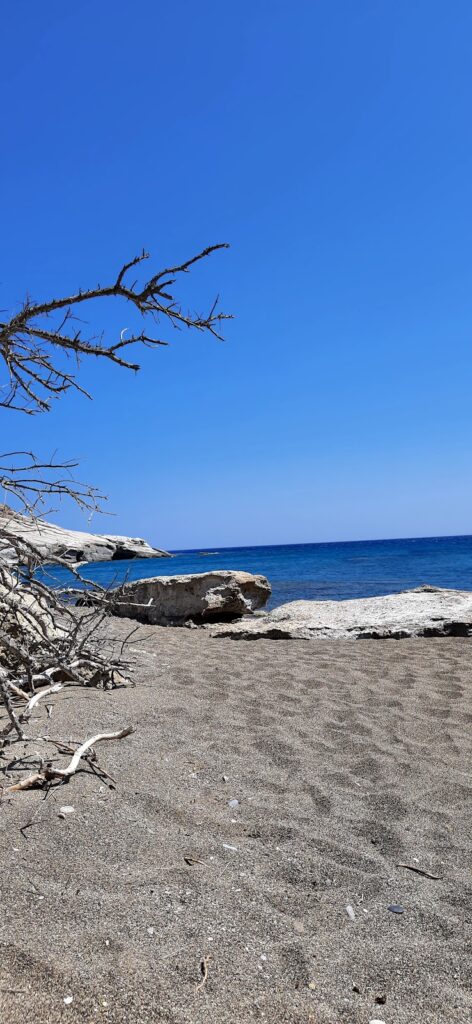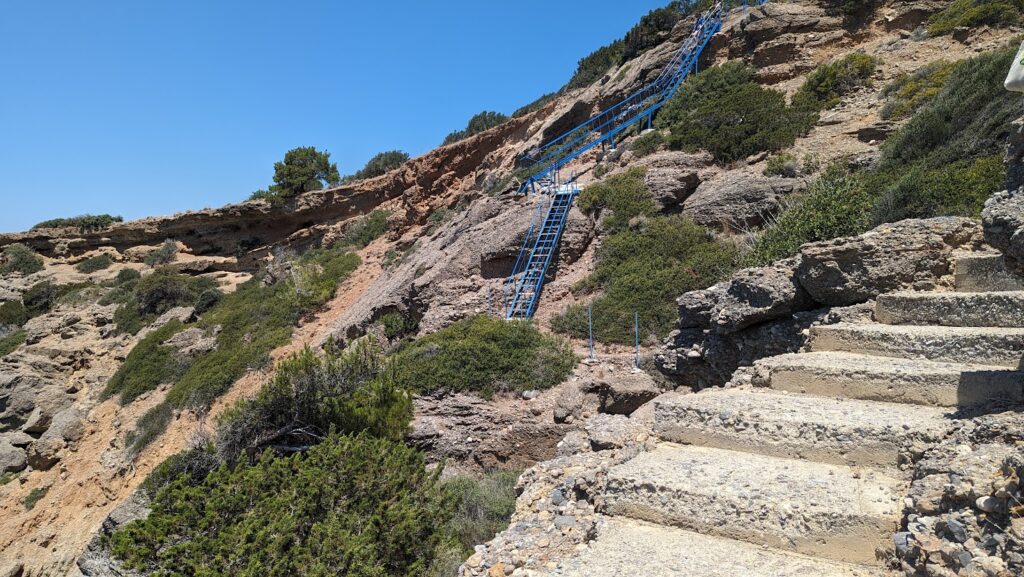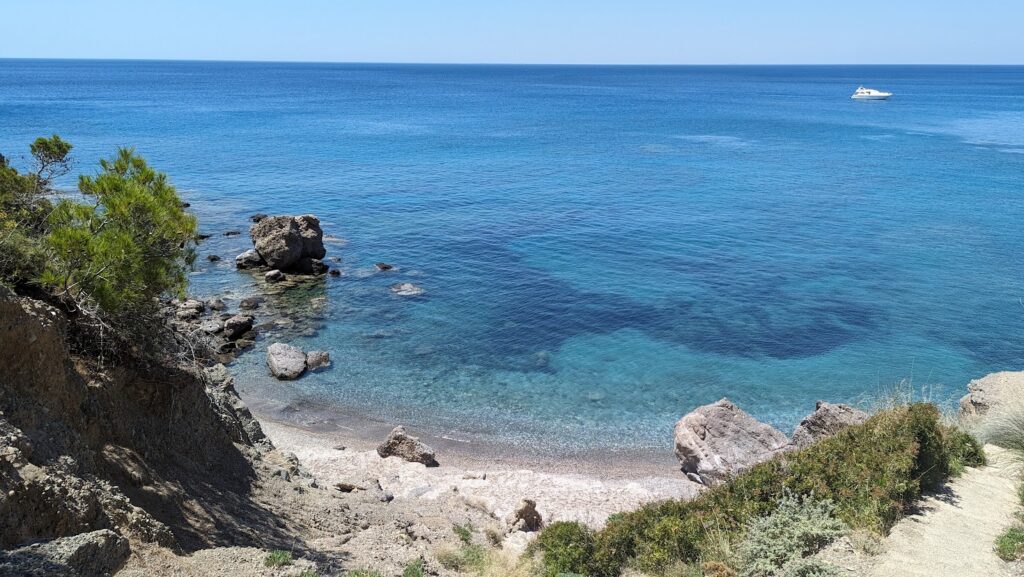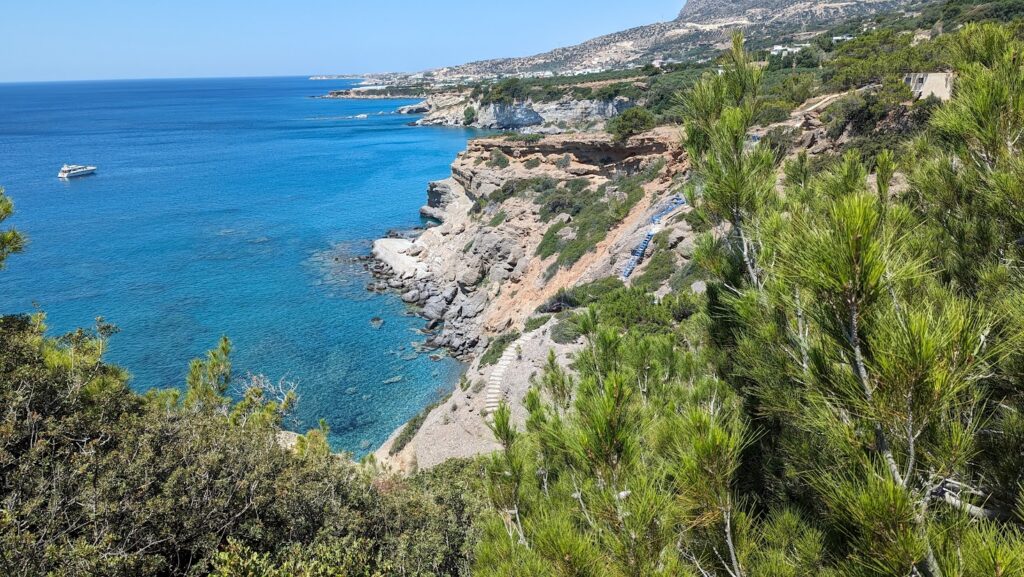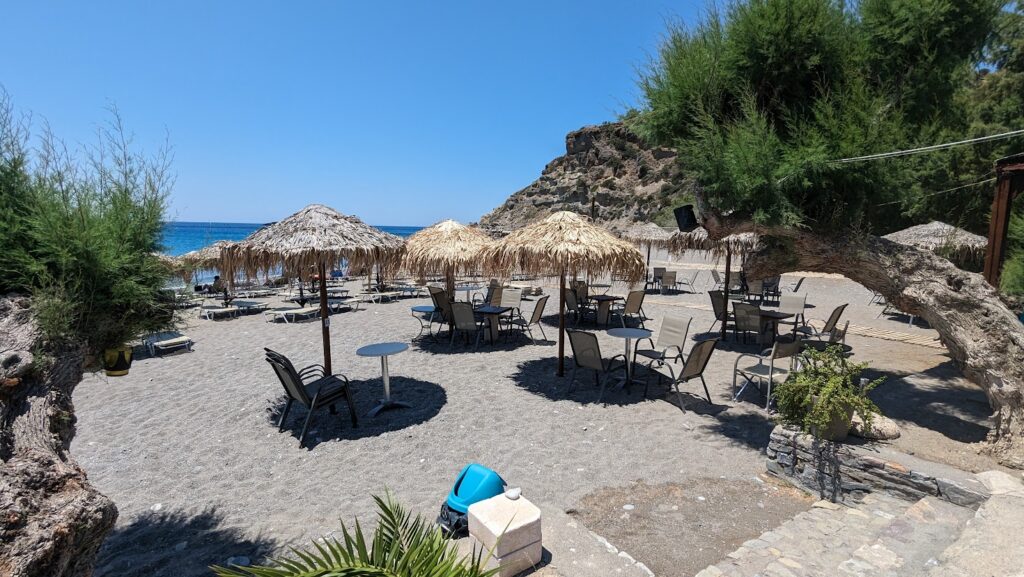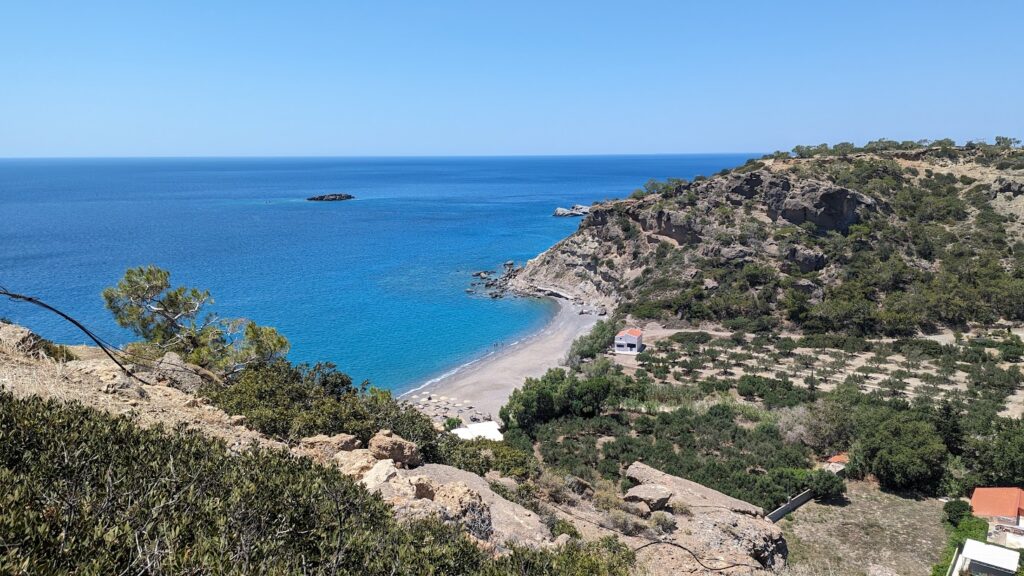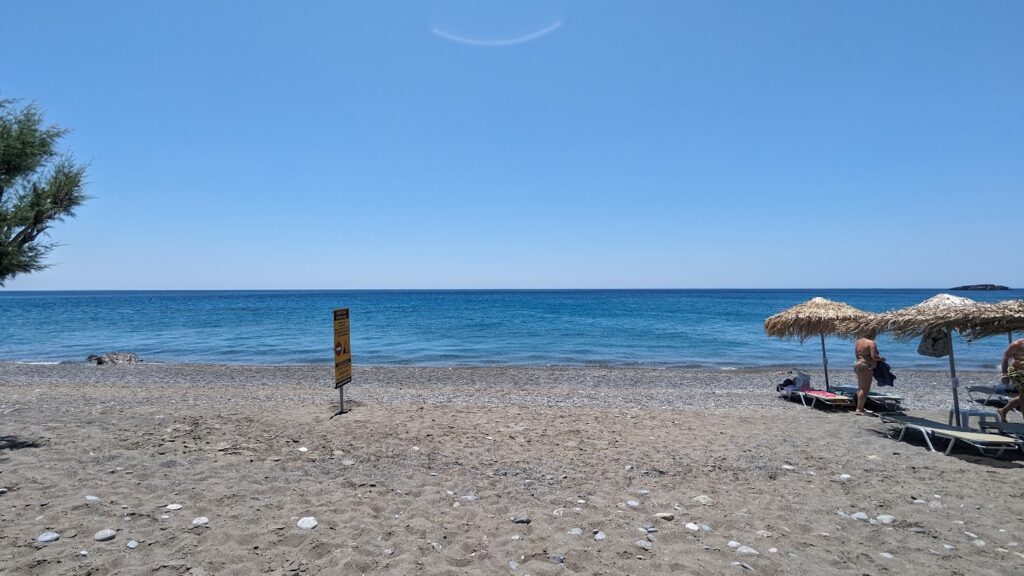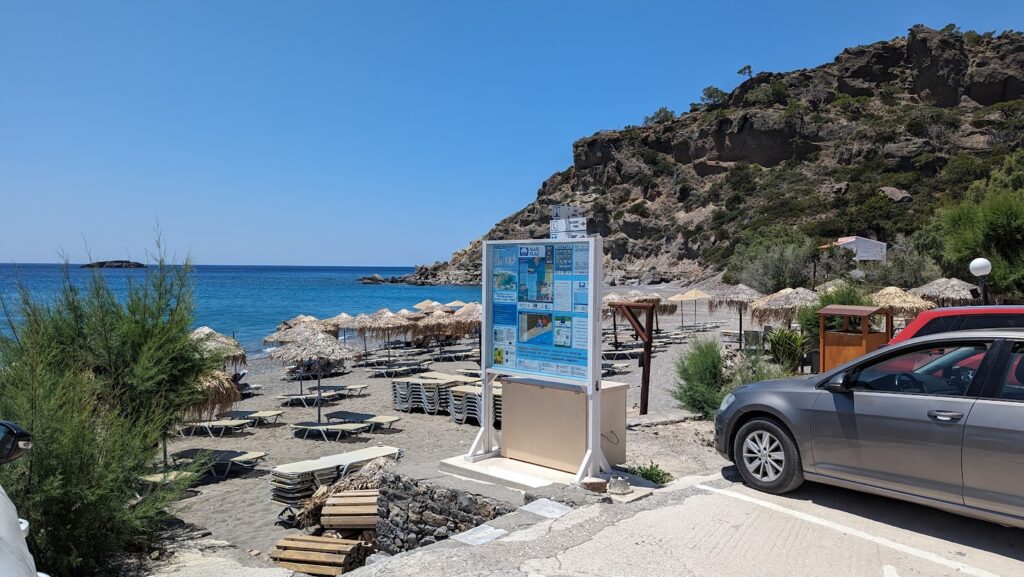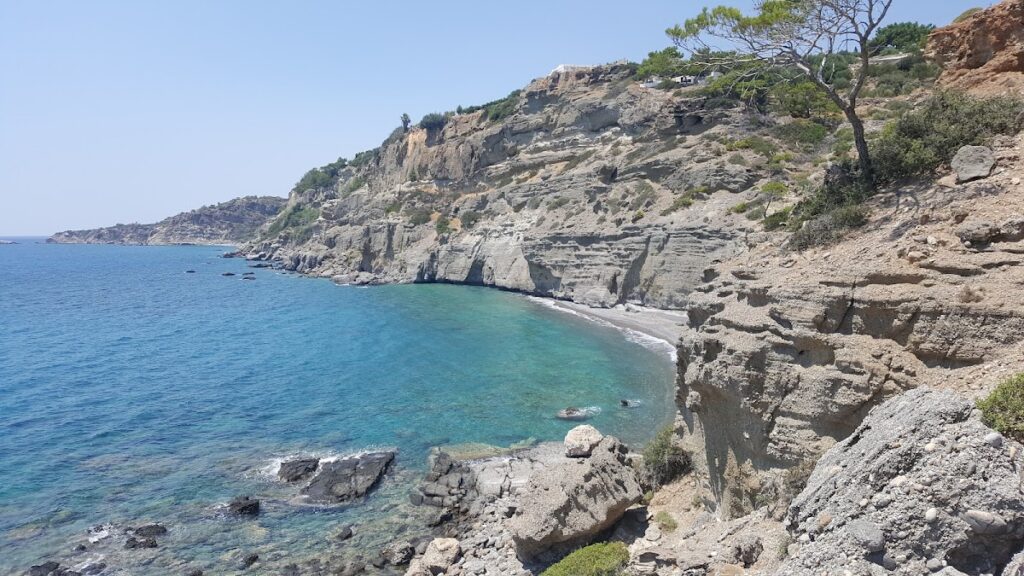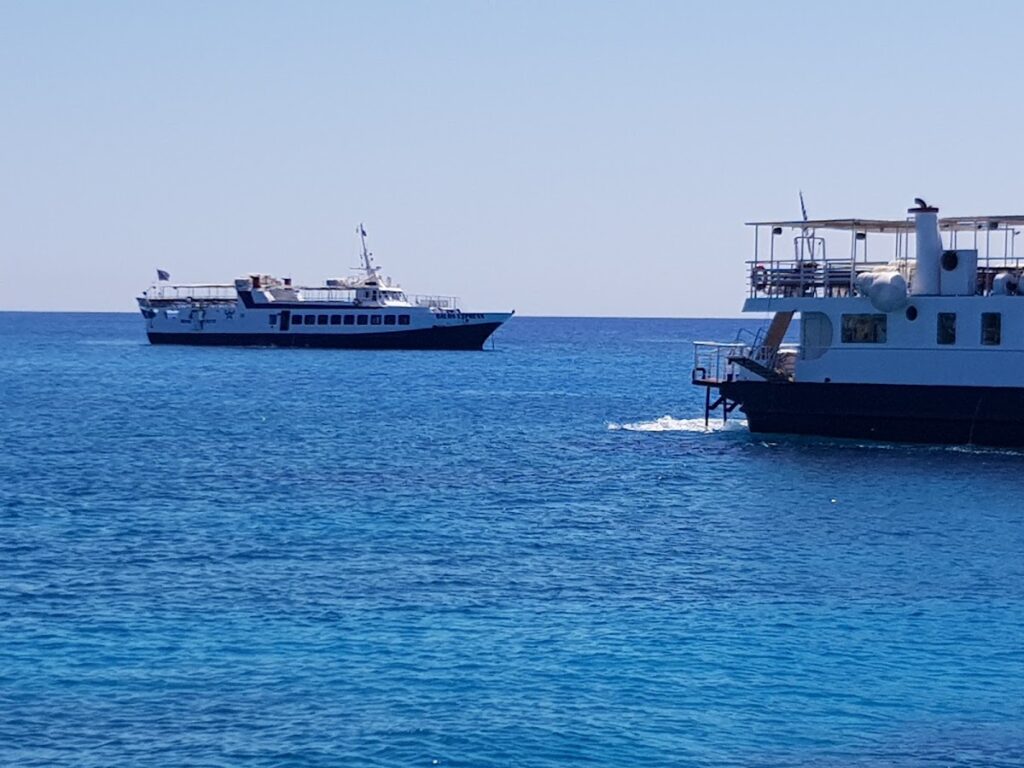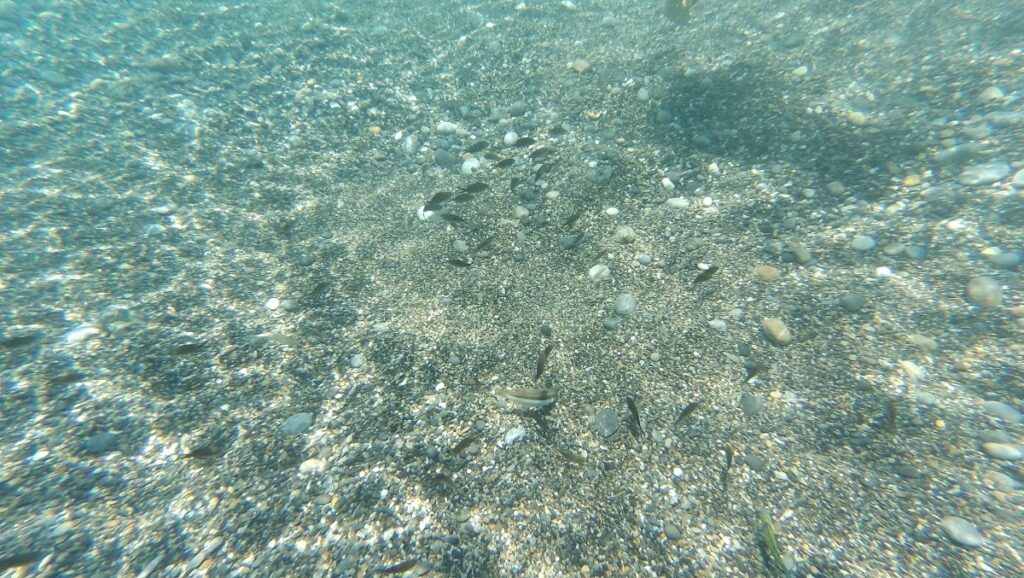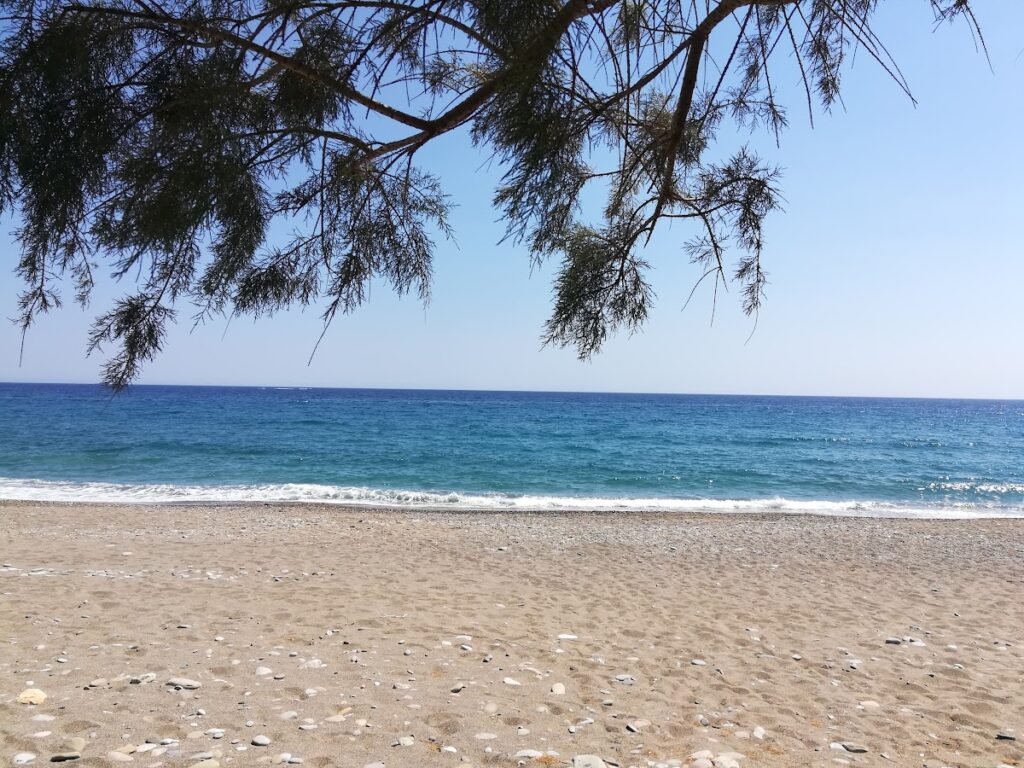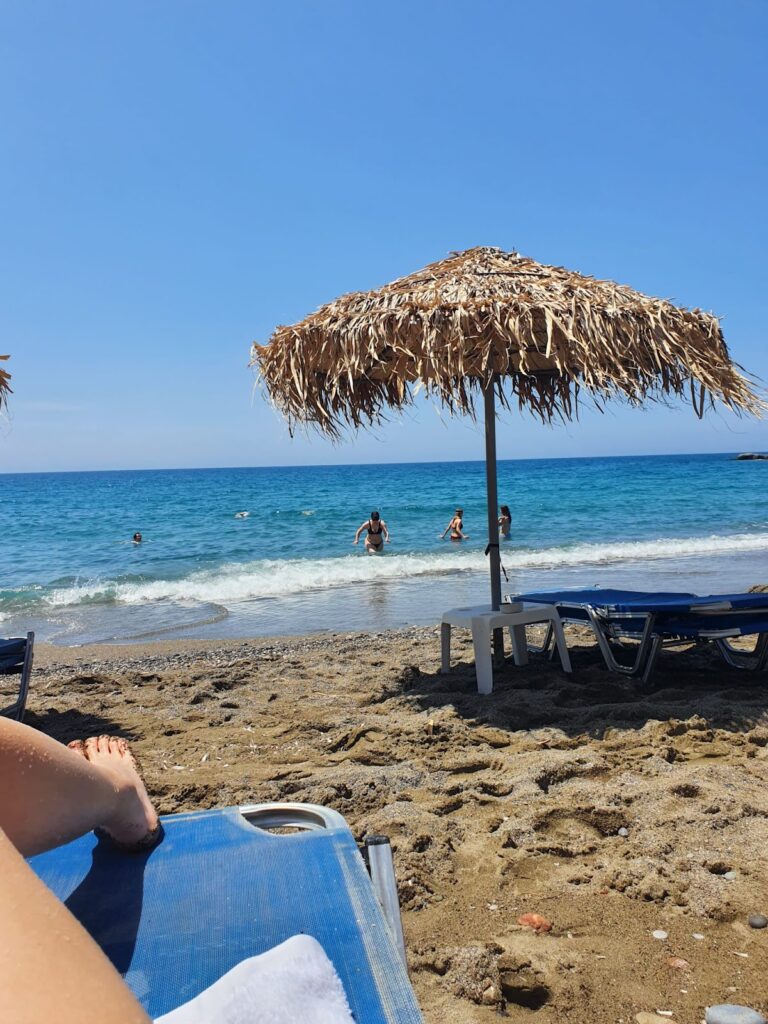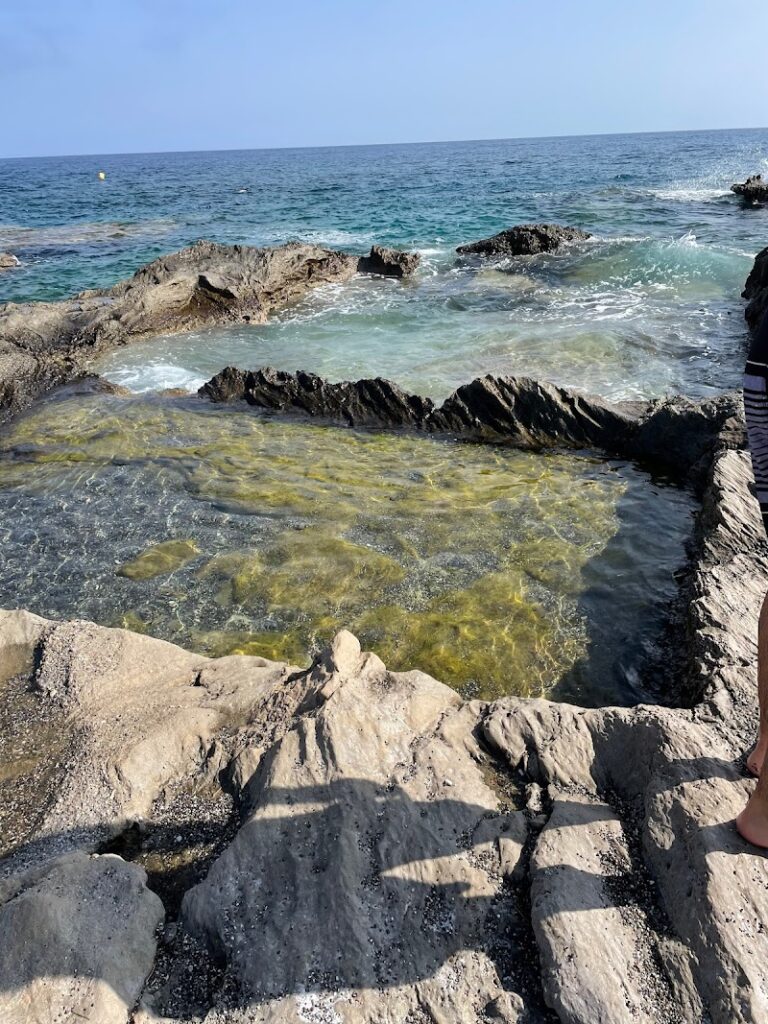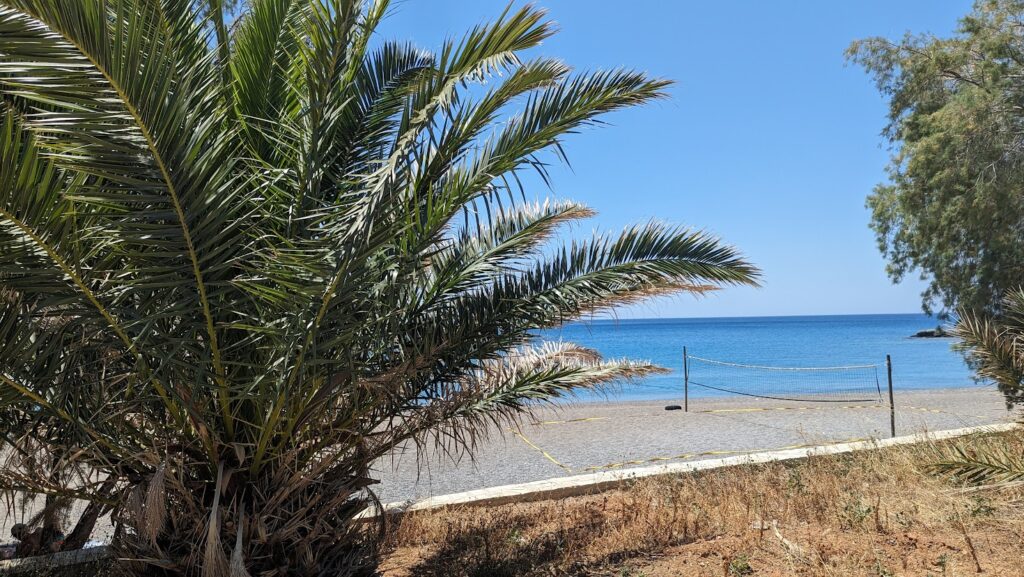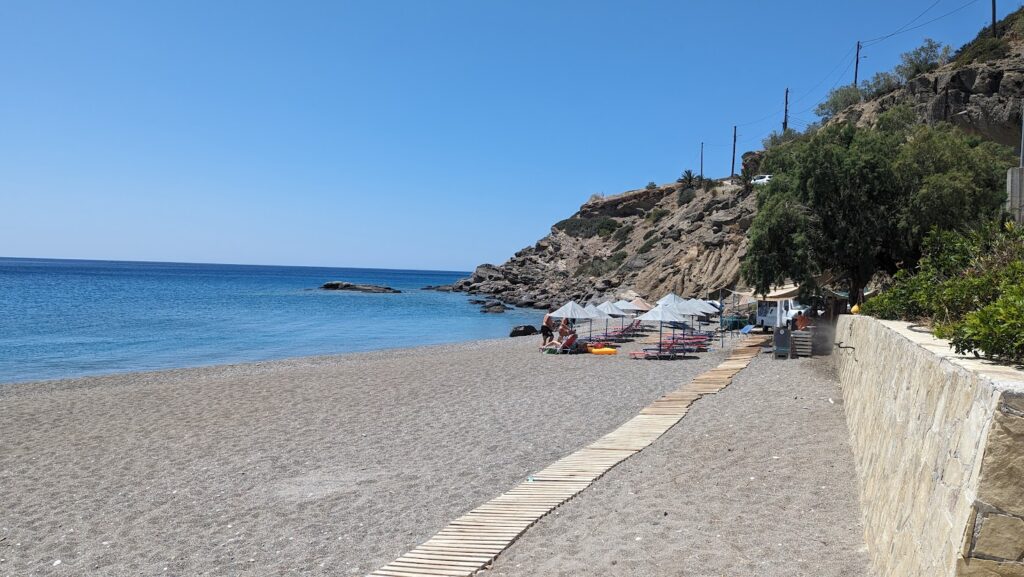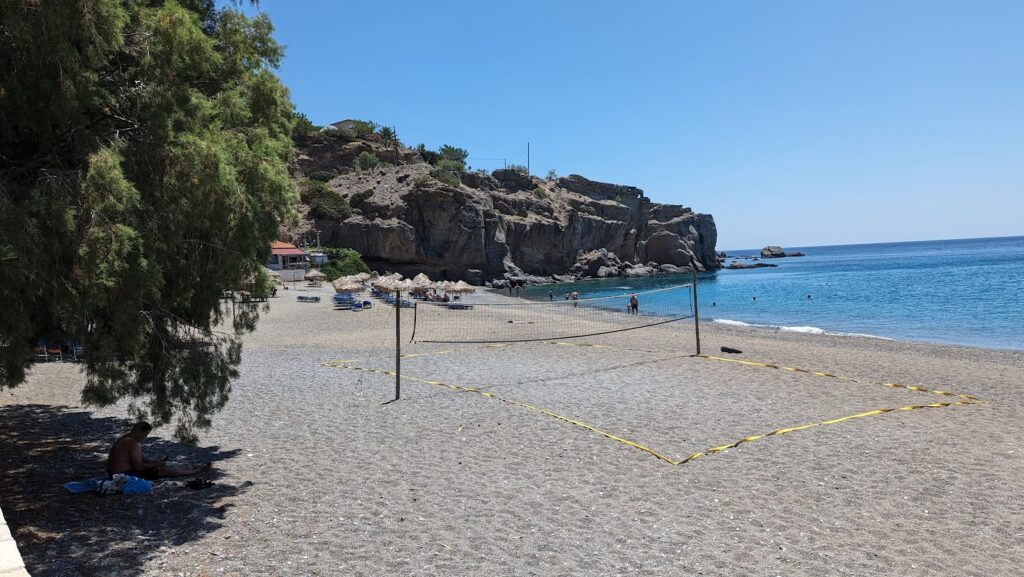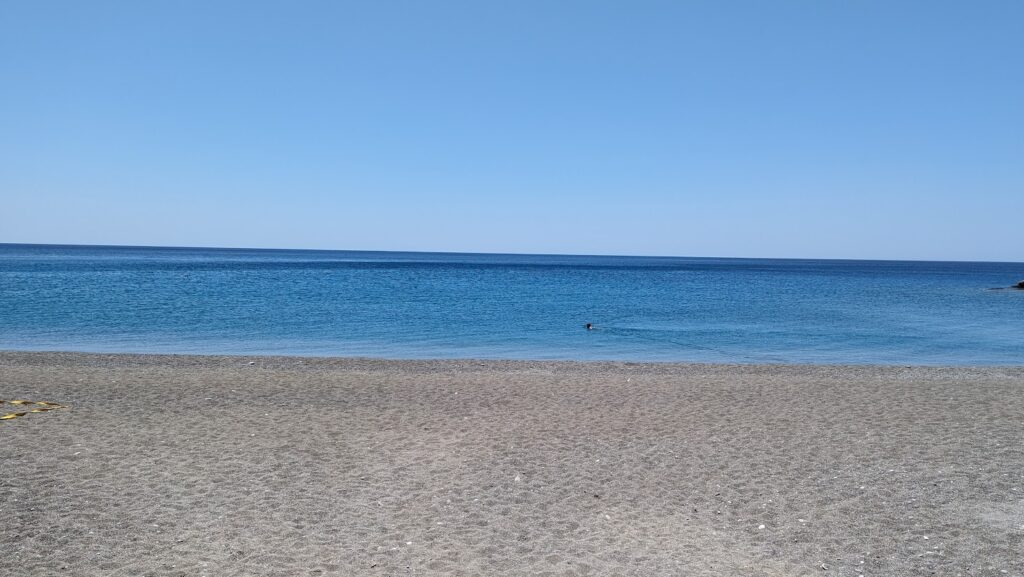Beaches near Férma, in Lassithi region
Here is list of closest beaches to Férma
- 490 m
- Ferma beaches
- Fine Pebbles, Sand
- Deep
- Blue
Ferma, a small coastal town, is situated 10km to the east of Ierapetra and 45km to the southeast of Agios Nikolaos, lying 4km south of the village, Agios Ioannis. The area is green and verdant, with dense pine forests, a stark contrast to the arid landscape of Eastern Crete. A string of tiny bays stretches along the coast, the largest being Livadi, also known as Ferma beach or Xerokamara. This beach, flanked by hotels, boasts fine pebbles, clear deep waters, and is bordered by lush vegetation and towering smooth rocks and steep cliffs.
Access to the unorganized beach is through two stairways starting from the nearby hotels. The beach features several springs and a small clump of Cretan Date Palm in its center. Following Livadi is Pigadi beach, named after a structure resembling a well. It, along with an adjacent small bay, can be reached via a stairway from the main road. The last beach in the area, Giorgakis, is similarly accessed via a steep path with iron stairs.
Ferma is known for its tranquil ambiance, making it an ideal spot for families to bask in the sun and enjoy the sea, with basic amenities within a short walk. If you’re visiting Ferma, ensure to explore the lush nature around. Check out the village of Agios Ioannis, stroll through its narrow lanes and churches, and visit the springs of Psychro and the Agios Ioannis waterfalls in the Milonas gorge.
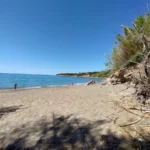
- 1.0 km
- Kakia Skala beach
- Fine Pebbles
- Normal
- Blue
Situated 46km southeast of Agios Nikolaos and 9km east of Ierapetra, lies the charming beach of Kakia Skala. The beach, moderately developed, is conveniently positioned alongside the main road that links Ierapetra with Makrigialos. It is uniquely set at the terminus of the majestic Agios Ioannis Gorge, which is home to Milonas waterfalls. The beach is adorned with fine pebbles and provides a serene environment with its crystal clear, calm waters. There’s no need for umbrellas, as ample shade can be found under the tamarisk trees.
The locals often refer to this area as Kakkos, named after the nearby Kakkos Bay hotel, which is a mere 200m westward.

- 1.3 km
- Giorgakis beach
- Fine Pebbles, Sand
- Deep
- Blue
Situated about 10km east of Ierapetra and 45km southeast of Agios Nikolaos, within the vicinity of the Agios Ioannis village, lies the beautiful Giorgakis beach. This stunning beach is nestled in the Ferma area, a region renowned for its numerous beaches. Despite being surrounded by towering cliffs, you can reach the beach via stairs originating from the Ferma Solaris Hotel. Once you descend, you’ll find yourself on one of the most picturesque beaches in East Crete, adorned with fine pebbles, rocks, and naturally formed caves.
The beach is segmented into two sections by a low-lying rock. The smaller western beach is the outlet of a local stream that meanders from the Strongyli peak region. Before reaching the beach, the stream creates a stunning waterfall, about 10 meters in height, which showcases vibrant rocks and dries up during the summer.
Ferma’s broader area is a lush oasis within the typically dry landscape of Eastern Crete, enveloped by pine trees and dense vegetation. Nearby, you’ll find several freshwater springs that continue to drip, even in summer, promoting the growth of such lush greenery.

- 2.1 km
- Agia Fotia beach
- Fine Pebbles
- Normal
- Deep blue
The beach of Agia Fotia is situated 45km southeast of Agios Nikolaos and 12km east from Ierapetra. It’s a small bay nestling at the outlet of a stream flowing down from the Thripti mountain. The name of the settlement is derived from the local Church of Agia Fotini, also known as Agia Fotia. The stream is cloaked by enormous plane trees, while the bay is encircled by conglomerate cliffs, adding to the enchanting landscape.
This beach is well-known and a favourite among the inhabitants of the city of Ierapetra. Its shores are covered in coarse greyish sand, while the water is crystal clear and tranquil. The beach is well-equipped with amenities including beach bars, taverns, and hotels. There are tamarisk trees on the beach where one can find shade. Additionally, beach volleyball tournaments are hosted annually at the local court, a recent tradition that has added to its popularity.

- 2.9 km
- Galini beach
- Fine Pebbles
- Deep
- Deep blue
Situated 47km southeast of Agios Nikolaos and 13km east of Ierapetra, near Achlia beach, lies the quaint village of Galini. Nestled amidst a lush landscape dotted with pine trees, Galini is a small yet slightly developed village. The coastline surrounding the village is marked by numerous hidden coves and pebbly beaches, only accessible via a few well-concealed paths.
Among these is Galini beach, a serene spot nestled between Ahlia and Agia Fotia. Characterized by fine pebbles and clear calm waters, the beach’s seabed is rocky in certain spots. The beach remains concealed from the main road due to towering conglomerate rocks and isn’t easily accessible, making it a quiet and ideal spot for those seeking solitude. While the beach is not organized, the proximity of village hotels and taverns makes it convenient for visitors. A short path from Galini’s main road leads directly to the beach.
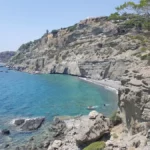
- 3.0 km
- Koutsounari beach
- Fine Pebbles, Pebbles, Sand
- Normal
- Blue
Koutsounari, a quaint seaside hamlet, lies 6km east of Ierapetra and 43km southeast of Agios Nikolaos. It nestles near the scenic village of Agios Ioannis, set against the backdrop of the Thripti Range. The village is perched on a verdant hill, surrounded by olive groves and pine trees, just a kilometer north of the South Cretan Sea coastline.
A kilometer to the south of Koutsounari is the expansive Long Beach of Agios Ioannis, stretching 5km, one of the longest in Crete. This broad, serene beach features the distinctive coarse grey sand typical of southern Crete. In many spots, tamarisk trees punctuate the landscape, and their length makes the beach appear deserted. The beach is somewhat organized in certain areas (near hotels) and is dotted with hotels, restaurants, mini markets, and a camping site.
If you venture eastward along the beach, you’ll encounter fewer swimmers. On the eastern end of Long Beach, a bay known as Psaropoula (named after an old local tavern) is shaped. Psaropoula features soft sand and tranquil waters, situated in front of a hotel, it is well-equipped with umbrellas, sunbeds, showers, and water sports. The sea here is typically calm, and the rocky seabed makes it a suitable spot for snorkelling.
Beyond Psaropoula lies another small cove boasting a well-appointed beach with umbrellas, showers, and water sports. This beach, located in front of the Kakkos Bay hotel, is called Villa Despot, translating to “Priest’s Villa” in Greek, named after a priest-owned building nestled between the two beaches. The beach is flanked by large rocks that provide a perfect spot for diving into the sea.
Visiting Long Beach in autumn offers a sight of the rare white sand lilies, signaling the summer’s end. These lilies are protected, so visitors are encouraged to appreciate their beauty from a distance without touching or picking them.

- 3.6 km
- Ahlia beach
- Fine Pebbles
- Normal
- Blue, Deep blue
Ahlia, also known as Achlia, is situated 50km southeast of Agios Nikolaos and 15km east of Ierapetra, within the jurisdiction of the village Schinokapsala. It’s a small community nestled in a cove, with the Thrypti Range’s steep slopes and pine trees surrounding it. The cove opens up into a stunning beach with coarse sand and vibrant blue water. The beach has minimal development, with only a few umbrellas, water sports, and some nearby accommodations, mini markets and taverns. Tamarisk trees provide shade for visitors, and the sea is usually calm. This location is perfect for a tranquil vacation, particularly for families.
The Achlia Gorge, which is small but reasonably wide, begins west of the Skinokapsala village at the Kipos location. The gorge, covered in pine trees, ends at Ahlia beach. During winter, water from the Thripti Range forms a river with several waterfalls (between 5 to 8 meters high) along its path. As the sandstone walls are not narrow, hiking is relatively easy without the need for canyoning equipment.
To get to Ahlia, take the main road east to Makrigialos, following the southern coastline of Crete, until you see the signpost for Ahlia. East of Ahlia, before reaching the Agios Panteleimonas community, you’ll find the small beach known as Bonda or Grias Pidima.

- 5.0 km
- Katharades beach
- Fine Pebbles, Rocks in places
- Normal
- Blue
Just past the Peristeras suburb of Ierapetra begins the Katharades area, a chain of small beaches leading up to the popular coastline of the Koutsounari village. Known for its strong winds, it’s considered one of Crete’s windiest locations. The bays of this area are somewhat hidden, despite their proximity to the main road, leading to few visitors to the sequential bays. The area also goes by the name Paplinou, due to the nearby ancient Panagia Paplinou monastery.
The stunning landscape is shaped by numerous rock shelters and unique rock formations, a product of erosion on the conglomerate soil over time. There’s been a slight increase in development in recent years, mainly due to the construction of large hotels near the coast. Consequently, the main road between Ierapetra and Makrygialos boasts a few restaurants, mini markets, and accommodations.
The beach features coarse grey sand, and its seabed has large, smooth rocks interspersed with sandy areas. The surrounding area is dotted with tamarisk trees offering shade, and umbrellas are also available. The beach is well maintained by the nearby hotels and features a beach volleyball court, sunbeds, showers, and water sports facilities.
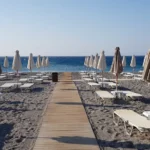
- 5.4 km
- Mavros Kolimbos beach
- Pebbles
- Normal
- Blue
The beach known as Mavros Kolimbos or Agios Panteleimon is situated 51km southeast of Agios Nikolaos and 16km to the east of Ierapetra. This quaint coastal settlement has experienced gentle growth over recent years. The area boasts several rental accommodations and small eateries. The beach itself is a charming spot with dark grey pebbles and typically tranquil waters. Some parts of the seabed are rocky, making it perfect for snorkelling. Although the beach is not organized, there are tamarisk trees nearby that provide natural shade.
To reach Mavros Kolimbos from Ierapetra, take the main road east towards Makrigialos, which runs along Crete’s southern shoreline. Public bus services are also available to Makrigialos and can stop in the area. If you’re driving, consider stopping by the mountainous Orino village in the Thrypti Range and the Gorge of Red Butterflies. Within the settlement, pay a visit to the Agios Panteleimonas church, from which the beach derives its alternative name.
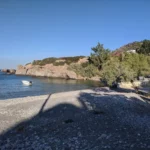
- 6.6 km
- Maheridia beaches
- Fine Pebbles
- Deep
- Blue
The beaches of Maheridia by Koutsouras village are a series of three different beaches with high cliffs. These beaches are all beautiful with crystal clear water and are only accessible by boat. The only one that can be accessed from the coast is the last beach to the east, accessed through two different trails hidden in the dense piney wood. The beach is only a few meters east of the well-known woods Apiganias at Koutsouras, in an area with many pine trees.
From the main road, a very short dirt road descends to the parking area where we meet a cluster of high pine trees. From here we have beautiful panoramic views of the eastern bay of Maheridia. Maheridia is a favourite destination for locals and you will very rarely see tourists. The picturesque bays are sandy and pebbly with some scattered rocks in places. The east bay at Maheridi is calm and windless almost all the time, being ideal for families with children.
The area is full of water springs, especially in winter and spring water gushes from everywhere and after a short distance reaches the sea. At some point the water is gathered, so one can see running water even in the dry summer months.
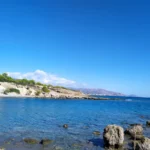
No results available
Reset


